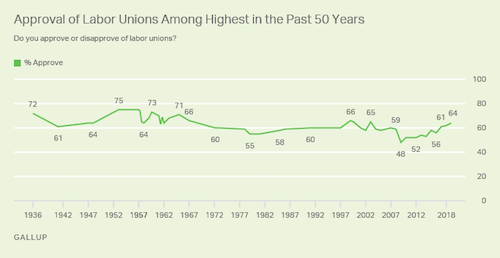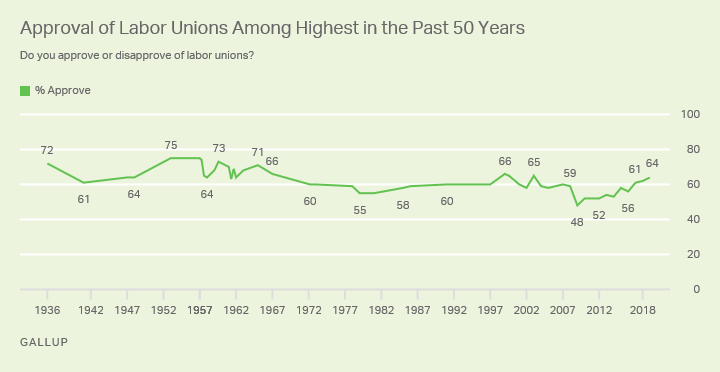Reports of labor’s demise have been greatly exaggerated according to a new Gallup poll.
According to the research organization, 65% of Americans approve of labor unions, marking a near 50-year high. That figure is up 16 points from the Great Recession low of 2008.
“These numbers are confirming what we’ve long known, that working people believe in their right to have a voice on the job, and unions are a proven way to achieve that,” said International President Lonnie R. Stephenson.


|
Labor union approval among the general public is at a near 50-year high. The chart shows popularity statistics for unions since the passage of the National Labor Relations Act in 1935
Credit: Gallup
|
Support is up significantly among political parties as well, with 82% of Democrats, 61% of independents and 45% of Republicans supportive of unions.
The findings appear to back up a 2018 study from MIT Sloan that found that almost half of nonunionized workers would join a union if given the opportunity to do so – a four-decade high. If that were to happen, almost 60 million more working people would have the protection of a union contract.
A Pew study, also from 2018, found that 51% of Americans said the decline in unionization has been mostly bad for working people; and in 2019 the research organization found that 45% of respondents said unions have a positive effect on the country, compared to 28% who described unions as having a negative impact.
Yet, unionization rate is at a historic low of 10.5%, half of what it was 35 years ago and far below its 1954 peak of 35%. If so many people support unions, why aren’t they in one?
Part of that answer may lie in education – or lack thereof – about unions.
“The idea and concept behind organizing your workplace is desirable to most workers when they are educated on what a union is,” said Director of Professional and Industrial Organizing Jammi Juarez. “I believe a lack of knowledge is holding down the growth of union workers in the United States. Until the conversation is had, most people have no idea what it means to be part of a union, what the union does or its purpose, including many union members themselves.”
The economy could also be a factor. People’s views on unions often move in concert with the economy, data shows, so when joblessness rises, union disapproval also goes up. That trend helps explain the low approval numbers during the Great Recession.
No so, today.
“In 2019, by contrast, one can’t plausibly pin America’s economic woes on Big Labor’s audacious wage demands or disruptive militancy,” wrote Eric Levitz for New York Magazine. “To the contrary, many of the U.S. economy’s most conspicuous problems — tepid wage growth, excessively low inflation and wrenching inequality — appear at least partially attributable to the union movement’s frailty.”
Multiple studies have shown a relationship between rising inequality and a shrinking labor movement. But with the current jobless rate at a near-historic low, there may not be as much incentive to organize your workplace.
“We know that workers will take a chance on organizing when work conditions are extremely bad,” Juarez said. “When [worker] demand is higher than the supply, like it is right now, workers think they can ask for better wages, benefits and schedules on their own. If they can get these things without without a collective bargaining agreement, they think, ‘Why take a chance and stick out your neck to organize?’
“I’d tell them that now’s the best time to do that – when they need you more than you need them – because the tide always turns, and then there’s no one to back you up,” she said.
And perhaps that mindset is catching on. In 2018, half a million people walked a picket line – the most in a generation. And this year has seen disaffected workers walk off the job from New York to Kentucky to California.
“I've never felt this much energy and determination from working people, said AFL-CIO President Richard Trumka in an August speech. “I've never seen this movement so driven to take the future into our own hands.”
In 2017, 75% of those who joined a union were under age 35. Considering that young people are more likely than their older counterparts to view unions favorably, according to 2017 research from Pew, this could be a sign of a new generation of activists. Young people also tend to support pro-worker policies and the politicians who support them. And, as the AFL-CIO noted, nearly 1,000 union members were elected to public office in 2018, ushering in pro-working-family policies this year.
“The strike wave and high union approval are part of a larger trend that we’re seeing now that is being driven by young people, especially young women and people of color,” said Georgetown University labor expert Lane Windham. “Young people are redefining the movement itself.”